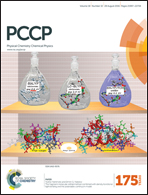Effect of the environmental humidity on the bulk, interfacial and nanoconfined properties of an ionic liquid†
Abstract
With reference to our previous surface-force study on 1-hexyl-3-methylimidazolium ethylsulfate ([HMIM] EtSO4) using an extended surface forces apparatus, which showed an ordered structure within the nanoconfined dry ionic liquid (IL) between mica surfaces that extended up to ∼60 nm from the surface, this work focuses on the influence of the environmental humidity on the bulk, interfacial and nanoconfined structure of [HMIM] EtSO4. Infrared spectroscopy and rheometry reflect the changes in chemical and physical properties of the bulk IL due to the uptake of water when exposed to ambient humidity, while wide-angle X-ray scattering shows a mild swelling of the bulk nanostructure, and the AFM sharp tip reveals an additional surface layer at the mica–IL interface. When the water-containing [HMIM] EtSO4 is nanoconfined between two mica surfaces, no long-range order is detected, in contrast to the results obtained for the dry IL, which demonstrates that the presence of water can prevent the liquid-to-solid transformation of this IL. A combination of techniques and the calculated Bjerrum length indicate that water molecules weaken interionic electrostatic and hydrogen-bonding interactions, which lessens ion–ion correlations. Our work shows that the solid-like behavior of the nanoconfined IL strongly depends on the presence of absorbed water and hence, it has implications with regard to the correct interpretation of laboratory studies and their extension to real applications in lubrication.



 Please wait while we load your content...
Please wait while we load your content...